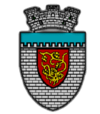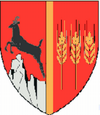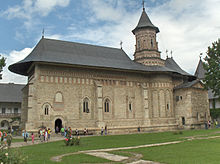- Târgu Neamţ
-
Târgu Neamţ — Town — 
Coat of armsLocation of Târgu Neamţ Coordinates: 47°12′9″N 26°21′31″E / 47.2025°N 26.35861°ECoordinates: 47°12′9″N 26°21′31″E / 47.2025°N 26.35861°E Country  Romania
RomaniaCounty Neamţ County Status Town Government – Mayor Decebal Arnăutu (Democratic Party) Population (2002) – Total 20,496 Time zone EET (UTC+2) – Summer (DST) EEST (UTC+3) Website http://www.primariatgneamt.ro/ Târgu Neamţ (also spelled Tîrgu Neamţ, Romanian pronunciation: [ˌtɨrɡu ˈne̯amt͡s]; German: Niamtz, Hungarian: Németvásár, Hebrew: טרגו נאמץ, Latin: Ante Castrum Nempch) is a town in Neamţ County, Romania, on the Neamţ River. It had, as of 2002[update], a population of 20,496. Three villages are administered by the town: Blebea, Humuleşti and Humuleştii Noi.
Contents
History
Originally a market town, hence its name (in Romanian "târg" = market), it had an important role in Moldavian culture. It was first mentioned in a late-14th century document.
The name neamţ is derived from the Slavic word nemeti meaning "snows". In many Slavic languages, nemeti also means "German", as Germans could not understand Slavic speakers when the cultures first met. "Neamţ" is also a generic name for the German people in the Romanian language. This may lead to speculation of a German foundation of Târgu Neamţ, according to which Saxon colonists crossed the Carpathians from the Bistriţa area and built a commercial township. Some Romanian historians, including B. P. Haşdeu consider that Târgu Neamţ was probably a Teutonic settlement from the 13th century, when the Teutonic Order made incursions from Transylvania against the Cumanic peoples that were living in Moldavia. Nowadays, historians disagree with this possibility mostly because of the long-lasting influences of the communist-nationalistic historiography which refused to accept the town was anything else than a Romanian-founded settlement.
Access
The town is located at the crossing of two national roads:
 and
and  . The planned East-West Motorway will bypass the town on its south when completed, providing access to Iaşi (to the east) and Târgu Mureş to the west. The railroad station is the terminus station of CFR Line 517 linking it to Paşcani via an electrified railway.
. The planned East-West Motorway will bypass the town on its south when completed, providing access to Iaşi (to the east) and Târgu Mureş to the west. The railroad station is the terminus station of CFR Line 517 linking it to Paşcani via an electrified railway.Tourism and attractions
- The Neamţ Fortress (Cetatea Neamţului) was built in the 14th century by Voivode Petru I (possibly on the ruins of a smaller Teutonic castle), and is located on the north bank of the Neamţ river.
- Târgu Neamţ is an appropriate starting point for trips to the monasteries in the region, located all on an average 15 km radius: Neamţ Monastery, Secu, Agapia, Văratec Monastery Sihăstria and Sihla Skete. It is close to Ceahlău, Durău and Valea Bistriţei.
- Ion Creangă memorial house in Humuleşti, across Ozana river: This is the house where the famous Romanian writer was born and where he spent his childhood. The stories from Ion Creangă's masterpiece Amintiri din copilărie ("Memories of my childhood") revolve around Humuleşti, Târgu Neamţ and in the surrounding villages.
- Monumentul Eroilor (Heroes' Monument): an obelisk that commemorates the Romanian soldiers from World War I is found on Dealul Pleşu near the Pometea suburb. It commands views of the town and the mountains.
- Vânători-Neamţ Natural Park, housing a herd of wisent, the European bisons that once roamed the Eastern Carpathians.
- Nicolae Popa ethnographic museum in Târpești[1]
Population
- 1992: 22,221
- 2002: 20,496
- 2007: 22,000
Natives
- Ion Creangă
- Gabriela Istrate
- Irving Layton
- Mariana Simionescu
- Metropolitan Varlaam
- Ioan Vieru
- Moshe Idel
References
Neamţ County, Romania Cities Piatra Neamţ (county seat) · Roman

Towns Communes Agapia · Alexandru cel Bun · Bahna · Bălţăteşti · Bârgăuani · Bicaz-Chei · Bicazu Ardelean · Bâra · Bodeşti · Boghicea · Borca · Borleşti · Boteşti · Bozieni · Brusturi · Cândeşti · Ceahlău · Cordun · Costişa · Crăcăoani · Dămuc · Dobreni · Dochia · Doljeşti · Dragomireşti · Drăgăneşti · Dulceşti · Dumbrava Roşie · Farcaşa · Făurei · Gâdinţi · Gârcina · Gherăeşti · Ghindăoani · Girov · Grinţieş · Grumăzeşti · Hangu · Horia · Icuşeşti · Ion Creangă · Mărgineni · Moldoveni · Negreşti · Oniceni · Păstrăveni · Pânceşti · Pângăraţi · Petricani · Piatra Şoimului · Pipirig · Podoleni · Poiana Teiului · Poienari · Răuceşti · Războieni · Rediu · Români · Ruginoasa · Sagna · Săbăoani · Săvineşti · Secuieni · Stăniţa · Ştefan cel Mare · Tarcău · Taşca · Tazlău · Tămăşeni · Timişeşti · Trifeşti · Tupilaţi · Ţibucani · Urecheni · Valea Ursului · Văleni · Vânători-Neamţ · Zăneşti
Categories:- Populated places in Neamţ County
- German communities in Moldavia
- Shtetls
- 13th-century establishments
- Towns in Romania
Wikimedia Foundation. 2010.





